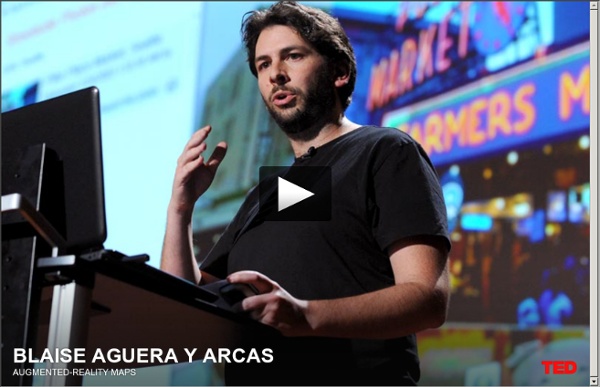



Goodbye Virtual Reality, Hello Augmented Reality inShare0 Credit: Wired If you haven’t yet heard about Augmented Reality or Web Squared, allow me to make a quick introduction. This is the next iteration of the Web and also desktop and mobile applications and is indicative of the future hybrid Web and device experience. And no, it’s not called Web 3.0. Augmented Reality joins the likes of the Semantic Web, Geo-Location, Artificial Intelligence, among many other emerging technologies in what the father of Web 2.0, Tim O’Reilly, refers to as Web Squared. Augmented Reality (AR) refers to the live direct or indirect view of a real-world environment whose elements are supplemented with, or augmented by, computer-generated imagery. What does this mean for you? As a user, Augmented Reality apps merge the virtual with reality – or the augmented data and objects with real life experiences. In the last weeks, we’ve witnessed the release of several new Augmented Reality applications for mobile platforms. Examples: Yelp’s Monocle My iPhone
PhotoSketch Sketch2Photo: Internet Image Montage Tao Chen1 Ming-Ming Cheng1 Ping Tan2 Ariel Shamir3 Shi-Min Hu1 1TNList, Department of Computer Science and Technology, Tsinghua University 2National University of Singapore 3The Interdisciplinary Center Abstract We present a system that composes a realistic picture from a simple freehand sketch annotated with text labels. Paper Sketch2Photo: Internet Image Montage ACM SIGGRAPH ASIA 2009, ACM Transactions on Graphics, to appear Tao Chen, Ming-Ming Cheng, Ping Tan, Ariel Shamir, Shi-Min Hu System Pipeline Retrieval Results Composition Results Video Supplementary Materials 1. General supplementary materials, including intermediate results and comparisons. 2. High resolution compositions and detailed statistics of the user studies. Sktech2Photo Team Tao Chen, Kun Xu, Fang-Lve Zhang, Meng Ding and Ming-Ming Cheng Update: A web-based Sketch2Photo application: click here (Chinese), collaborated with Tencent. Acknowledgments Note Original Name: PhotoSketch.
welovelean : In case you missed it, my latest... La réalité augmentée Selon Ronald Azuma, chercheur à l'université de Caroline du Nord, la réalité augmentée doit respecter trois règles fondamentales : combiner le réel et le virtuel, de manière interactive (en temps réel) et en respectant l'homogénéité perspectiviste. Cette définition exclut donc les simples collages 2D qui ne respectent pas la cohérence 3D, ainsi que la composition en post-production qui n'est pas temps réel. En revanche, elle n'impose aucune contrainte sur le réalisme photométrique des compositions (par exemple, les objets virtuels peuvent être affichés en mode filaire). La visualisation peut se faire à l'aide de lunettes stéréoscopiques particulières, qui permettent de voir la réalité en même temps que les objets synthétiques représentés en relief. Les premiers mélanges entre images filmées et images numériques ont été réalisés pour le film Tron de Steven Lisberger (1982). Le pendant interactif du cinéma des effets spéciaux est le jeu vidéo. Cohérence spatio-temporelle
Basics of Cloud Computing Michael Wood Michael R. Wood is a Business Process Improvement & IT Strategist Independent Consultant. Michael is creator of the business process-improvement methodology called HELIX and founder of The Natural Intelligence Group, a strategy, process improvement, and technology consulting company. He is also a CPA, has served as an Adjunct Professor in Pepperdine's Management MBA program, an Associate Professor at California Lutheran University, and on the boards of numerous professional organizations. Mr. Maybe you have heard about Cloud Computing, maybe not. Like the song says, “Let’s start at the very beginning, because it’s a very good place to start." Cloud Computing has its roots in the service bureau concepts of the 1960s.
10 ways you’ll probably f**k up your startup — Spook Studio 1. No clear vision or purpose This should be the starting point for any startup founder, but it’s often overlooked. Too often people dive straight into their shiny solution ideas without thinking about why they’re doing what they’re doing or considering the change they want to see in the world. “Chase the vision not the money. Without a clear purpose, a startup can meander along without much momentum. “To be the pulse of the planet” —Twitter “To be the earth’s most customer-centric company” —Amazon Simon Sinek points out in his renowned TED talk ‘How great leaders inspire action’ that you need to awaken an emotion with your early customers so that they feel something, come back for more and, most importantly, tell their friends about you. “People don’t buy what you do, they buy why you do it”Simon Sinek If your customers believe in your mission, then they’ll warm to you and listen to what you offer and how. 2. “People who focus exclusively on efforts that matter, succeed. 3. 4. 5. 6. 7. 8.
SixthSense Un article de Wikipédia, l'encyclopédie libre. Projet en cours de développement en 1998[1] L'invention s'appelle "aremac"[2]. Le projet SixthSense (« sixième sens »), parfois dénommé WUW pour Wear ur world, est un projet d'ordinateur ubiquitaire et dématérialisé. Ce projet est en cours de développement au MIT par Steve Mann, Pranav Mistry et Pattie Maes au MIT Media Lab et a été présenté en 2001[2]. Ce projet était intitulé à l'origine Synthetic Synesthesia of the Sixth Sense[3],[4]. Il s'agit d'un système logiciel et d'interfaces permettant de transformer des objets de l'environnement quotidien en des éléments d'un ordinateur semi-dématérialisé, qu'on emporte avec soi ; de nombreux objets deviennent supports possibles d'information ou d'interaction. Innovation[modifier | modifier le code] C'est un concept qui a rapidement attiré l'attention des médias spécialisés, mais aussi du grand public [5]. Principes[modifier | modifier le code] Objectifs[modifier | modifier le code] (en) P. (en) P.
What Is The Singularity And Will You Live To See It? 1. I'm generally skeptical of the singularity and of post-scarcity economics in general. 2. I think it's interesting to ponder why the singularity might not occur. 3. 4. 5. 6.